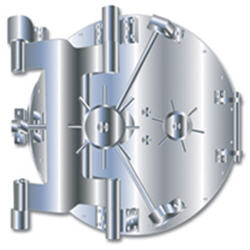
The article below I am reprinting here (without permission, James has no idea who we are and won’t return our phone calls I’m sure)…
but you can view it on GoldMoney’s site by clicking here.
Using Vaults to Store Gold and Silver
I consider gold and silver to be the bedrock asset of an investment portfolio. In other words, it is the foundation stone upon which the rest of a portfolio is built. Given this important role in which I hold the precious metals, it is essential to keep them safe.
Safety can mean different things to different people. Until recently, for example, many investors believed that Switzerland was isolated from the world’s monetary turmoil. They therefore thought that the Swiss franc was a safe place to keep their money, but the illusion of safety vanished instantly when the Swiss National Bank announced that it would not let the Swiss franc strengthen beyond 1.2 Swiss francs per euro.
US government debt instruments are another asset class that in reality offer only the illusion of safety. Scottish author and historian Niall Ferguson has warned that T-bonds and T-bills are a safe haven like Pearl Harbor in 1941.
Gold and silver are safe havens because they are tangible assets. Therefore, they do not have counterparty risk. In other words, there is no risk of default, but only if you own physical metal. Paper-gold and paper-silver are financial assets and therefore have counterparty risk. They only offer the illusion of gold and silver ownership.
So how does one keep their physical metals safe?
Diversification of one’s metal is probably the most important objective, to mitigate the risks of government confiscation, loss from war and similar extraordinary events. Store your physical gold and silver in different geographic locations, namely, in different cities in different countries. Even though you do not have your metal at hand, this disadvantage is outweighed by the benefit of protecting your metal with global diversification.
To achieve this objective conveniently and safely you will need to use professionally managed vaults. So vaulting is an important factor to consider when buying gold and silver.
Always use non-bank vaults. Because banks are in the business of lending, one is never certain whether your gold is there or not. In contrast, non-bank vaults are in the business of storing, so everything they do is aimed at enhancing their storage business. Safeguarding their customers’ assets is therefore an essential building block of their business model.
Safe deposit boxes are safer than placing your precious metals directly with a bank, but they too have risks. They may be difficult to access when you need your metal, and may not be practical or cost effective for storing large amounts of silver. Also, it is inconvenient and risky to take your gold and silver to safe deposit boxes in different countries to meet the objective of obtaining geographic diversification.
Regardless where and how you choose to store your precious metals, insurance is recommended. Professional vault operators will provide proof of insurance, thus protecting your metal from normal commercial risks. If the vault doesn’t insure your metal, don’t use it. In conclusion, there are advantages as well as disadvantages to using vaults for storage. Nevertheless, they should always be considered because they offer the most practical way to attain the important objective of keeping your precious metals safe, namely, storing them in different countries.
Learn more about safely storing gold in overseas vaults via GoldMoney